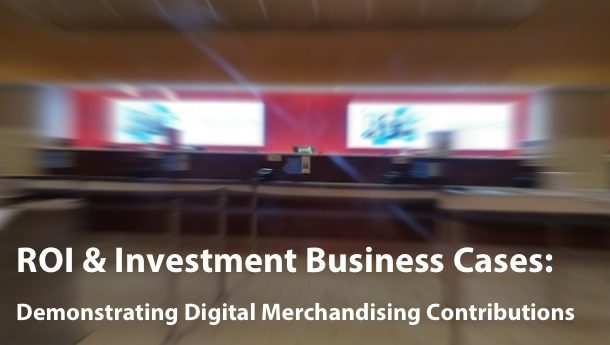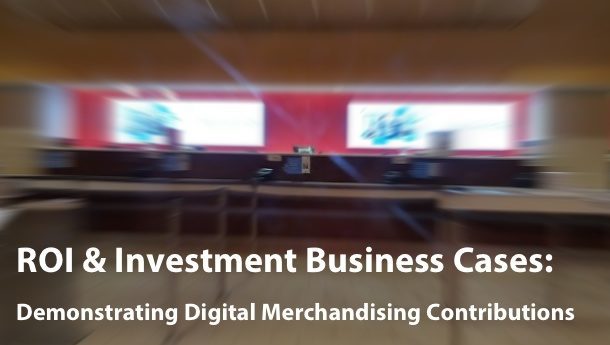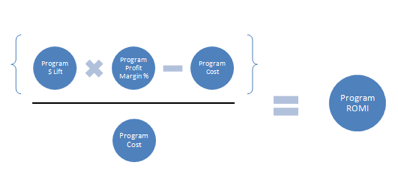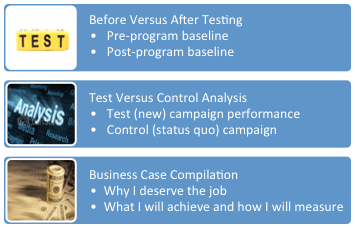
WHITE PAPER: In-Store Digital Signage
November 27, 2012 by guest author, Tony Wenzel

Tony Wenzel, SVP Sales at STRATACACHE, has developed a white paper on the strategy to apply to in-store digital signage – focused on banking but more broadly applicable.
Wenzel is delivering technology solutions that support large-scale digital merchandising initiatives for the banking, retail, C-store, and QSR verticals.
Executive Summary
Bank executives routinely ask sponsors of in-store digital signage programs to demonstrate their contributions to the business. The requests are often addressed to marketing, real estate, and IT sponsors. “Prove it” requests come at any time in an initiative’s lifecycle. Some come before the digital signage network is in place, some during pilots, and some after the networks are in place. This paper addresses ideas for building a compelling business case for program funding and provides simple ideas for demonstrating program proof-of-impact.
Rationale: What Digital Communication Networks Are Designed To Do
Why are we doing this?
The functional reasons banks install in-branch digital signage systems typically fall into three areas:
- to drive brand awareness
- to generate new incremental sales
- and to empower branch associates (to better customer-facing conversions).
Nearly all potential business contributions can be tied back to one of these functional categories.
1. Bolster brand awareness (create differentiation)
Brand is imperative because most consumers see banks as commodity service providers. Branding is the differentiating component in customer experience management. The ability to deliver specific messages to specific segments in specific locations – the way digital merchandising systems do – helps bank marketers create a focus on a customer-centric rather than a product-centric brand value.
More than ever, customers own the brand. The products you sell are not as important as the customers who buy them. So messaging to customers properly is critical to their experience and the brand. A positive in-branch experience is highly correlated with customer loyalty.
Digital signage marketing channels deliver statements that reinforce brand and provide metrics to measure the impact of messages on consumers in specific locations. For some, even the physical display(s), design, configuration, surrounds, and integration will say as much about your brand as the outward messages.
2 – Generate sales (identify latent demand)
Financial institutions can advance sales and customer relationship management (CRM) efforts by delivering relevant video messages to specific digital signs, in specific branches, at specific times of day. A study by OTX shows that 40 percent of people surveyed said they were likely to pay attention to merchandising while at the bank. Even if that number dwindled by half, it yields considerable improvement over traditional broadcast and direct mail marketing efforts. Experts indicate only one in 100 bank visitors make product inquiries. Digital signage channels generate sales by improving product awareness via targeted messaging and contextual imagery.
3 – Empower branch associates (train people to convert leads to sales)
Branch associates account for over 95 percent of all customer contact. Yet, Booz Allen Hamilton reports that “most customers don’t see banks as providers of advice-based services – the holy grail of wallet penetration.”
Preparing associates to consultatively support customer needs is critical to increasing customer satisfaction and creating more opportunities to up-sell. This is especially true today as customers are more empowered and knowledgeable than ever.
In-store media addresses both internal associate and external customer audiences. During the workday, it is a marketing tool. After hours, it can provide on-demand video to branch employees for training, education, and compliance. Interestingly, branch employee satisfaction is highly correlated with customer satisfaction. It’s likely that programs designed to provide better information to customers will also reduce employee turnover rates.
Building a Business Case: More Than Creating A ROI Model
They asked for ROI. Show them something better.
A return-on-Investment (ROI) analysis is one type of analytic element that you may choose to include in a comprehensive business case (or funding request). The term ROI is trendy catch-all phase. What most people want to understand is “what is the business case?”
A business case is a comprehensive explanation of who you are, what you intend to do, how you will measure success, and why it is worth doing. A business case is about persuasion. It aggregates critical information to justify a funding commitment in a practical, actionable format.
Significant items to build into in the business case include:
- an overview of your competency,
- an explanation of your methodology for defining and measuring success,
- appeals to sensation,
- and business support.
1 – Demonstrate Competency
Explain why you deserve the job.
The overview of competency explains why the team is qualified to execute and deserves to own the initiative. The explanation should have three parts: a resume describing team member’s prior successes, a portfolio of your vendor’s successes and references, and a history of similar sorts of projects, both internal and external.
A portfolio containing information about the sponsor’s experience in other projects is vital. Demonstrate competency of the internal team as well as the external resources needed for the project. Showcase recent and or relevant successes. The goal is to build credibility for the team members, highlighting wins on similar projects or in similar industries. Third-party analysis can provide instant validation as well as meaningful industry benchmarks and targets. It is a lot easier to approve funding for someone with a history of success or for a program that resembles a similar successful program.
2 – Explain Methodology & Define Success
Your methodology defines the program’s objectives and the measures of success. The specific objectives should be communicated using terminology and KPIs your organization is familiar with. Explain what you will measure, how you will measure it, and the projected (or demonstrated) results.
In retail banking, measures for improvements in efficacy might include:
[checklist]
- levels of branch traffic
- facings, inquiries
- conversions
- training sessions
- service perception
- customer education sessions
- wallet-share improvements
- customer feedback details
[/checklist]
Highlight the metrics have the most weight for your firm. Describe how the metrics align with corporate objectives stated in your company 10K. Consider the organization’s overall objectives both short-term and long-term. For example, how will the program improve overall efficacy? Will it make doing business with the bank more convenient, help sell more fee-based products and services, boost deposits, improve customer service, or better the customer experience?
The metrics employed to demonstrate success may be expressed in both financial and experiential terms. However, unless the experiential metrics speak for themselves, and in some organizations they might, at some point the methodology must explain how experiential measures translate into financial impact.
For example, the bank probably has a formula to determine the difference in lifetime customer value between a Net Promoter Score of six or seven versus a score of eight or nine. So, if the program converts 100 customers from a score of seven to a score of eight, and the value of the improvement averages $60,000 in net promotion over the customer lifetime, explain how the initiative will deliver $6,000,000 in value.
Metrics
Here are some examples of hard and soft metrics that can help quantify the contribution a digital signage program can make:
Behavioral Contributions including measurements of conversation frequency, mobile banking application downloads, and product inquiries.
The program will improve customer facings by 20%.
The effort will drive a 12% increase in mobile banking adoption and a 4% increase in traditional on-line banking reducing branch transactional load by 5% and reducing customer service calls by 2%.
Attitudinal Contributions including measurements of awareness, loyalty, or advocacy and net promotion.
The program will improve brand awareness in the region by 28%.
Productivity Contributions speak to associate enablement and education, like measurements of the timeliness and relevancy of training materials received or associate knowledge score improvements. They might also include improvements to the customer experience that affect efficiency, like customer queue-time improvements.
The program will provide associate training an average two weeks earlier for each merchandising campaign, will improve associate scores on the financial planning index test, and will eliminate the need for certain types of travel, saving approximately $7,500 per regional campaign.
Transactional Contributions (and Savings) include both direct dollar and indirectly attributable contributions or savings that impact the bottom line.
Direct transactional contributions include basic metrics like the dollar amount of new incremental deposits or new loans. Direct savings like the dollar value of reductions in network transport costs, print spend, or travel costs fit here too.
Indirect transactional contributions are calculated by attributing dollar values to experiential or qualitative metrics. For example, by calculating the dollar value of a six-point improvement in brand perception score, one can determine the value added. Indirect savings are calculated by attributing the value of improvements in quality and process to create a dollar value. For example, the value of reducing service calls by 1%.
As a result of the higher number of facings the bank will generate $14.5MM in new loans during the program period. As a result of transactional offload, the bank will save $27,000 over the next three years and shave 12 seconds off of the branch queue time average. As a result of the lower number of service calls the bank will save $55,000 over the next three years. As a result of improved brand awareness, the bank can expect to generate 3% more net new accounts this year.
Costs & Analysis
The methodology section will cover the costs and an explanation of how the value of the investment will be measured.
Capital costs should include the capital cost of any necessary equipment, software, and installations. Operating costs should include the operational cost of care and feeding, like costs for: new hires, network transport, data center space, server management, application management, application support, content production, and pro-active field services. Reserve costs should explain reserves to cover contingencies that cannot be mitigated.
Analysis
There are many sorts of analysis with which to make a successful business case. ROI is a common request of souls making budget requests. ROI is a capital investment metric that looks at the future returns on capital spent today over a fixed period of time. ROI is commonly applied to business acquisitions or business project investments. Marketing investments are different sorts of “risks” because marketing spend is expensed in the current period, making future cash flows irrelevant in the true “ROI” sense. Measures seeking to calculate return-on-objective are likely more relevant for a digital signage use case than ROI. Ideas like return-on-marketing investment (ROMI), which measures dollar returns on marketing budget spend, are likely better models for quantifying a program’s contribution to the business.
Figure 1 – Simple example of program Return–on-Marketing Equation
Return-On-Marketing Investment (ROMI) is a value-added model that considers the impact of marketing dollars risked over a given expense period. ROMI measures the amount one can attribute to marketing efforts (net of marketing spend), divided by the dollars “risked”. The difference between the term risk and the term investment is important. Dollars risked (budget line item) are considered different than dollars invested (expense/balance sheet item) as budget dollars are not committed to heavy depreciable assets in the same way that plant, equipment, and inventory dollars are committed.
Using the equation above, if a $5000 program drove $200,000 in new incremental sales at a 10% profit margin contribution, the return-on-marketing objective would be positive at a ROMI index of 3, meaning it would earn 3 times the risked cost for an ROI of $15,000.
Calculate as $200,000 X 10% = $20,000 – $ 5000 = $15,000 / $5000 = 3.
Similarly, using the equation above, if a $2000 program drove $50,000 in new incremental sales at 12% profit margin, the return-on-marketing objective would be positive at a ROMI index of 2, meaning it would earn 2 times the risked cost for an ROI of $4000.
Calculate as $50,000 X 12% = $6000 – $2000 = $4000/$2000= 2.
When the ROMI index is positive, the investment is cash-flow positive.
Defining Success Depends Upon Your Objective
Without concrete objectives, a business case tries to build the airplane in flight. The response type depends on how high the bar is set and who the stakeholders are. Approval for some initiatives might require a detailed business case. Other requests might only require a review of simple metrics.
For example, a line-of business-owner from card services might want different information than the Chief Marketing Officer. If Card Services wants to drive credit card applications up by 30 percent in the course of a three month campaign, start at the baseline. Say the baseline is 300 applications per month. Multiply by 1.3 to get a program target of 390 applications per month. In this case, the objective is to collect 1170 applications in a three-month period. If ex-post the campaign delivers 1200 applications over three months, show that the program produced a more than 30% increase (33% or 1/3) in application collection. In this example, if the primary stakeholder is Card Services, a simpler performance metric may be enough to justify project investment or may be enough to green light the project.
Keep your corporate objectives and corporate culture in mind. It is easier to illustrate ideas with metrics and processes in which your company has already invested. Known processes are easy to understand and give you authority and credibility. Employ ideas, metrics, and surveys your executives know or value, like: Lifetime Customer Value, Net Promoter Score, accounts opened, or applications submitted.
Types of Analysis
There are several kinds of analytic models you can put forward in your business case including: before/after, test/control, multi-variable regression analyses, and more. The simpler the model, the easier it will be for funding authorities to understand the results. A combination of before/after and test/control studies is a powerful way to demonstrate how programs have performed and to align expectations for the future. Before/after and test/control studies are equally well suited to digital signage funding requests for infrastructure initiatives, programs, and pilot test.
Figure 2 Simple Types of Analysis
SAMPLE DIGITAL SIGNAGE PILOT TESTING OUTLINE
The purpose of the pilot is to empirically determine the costs and benefits of pursuing versus not pursing an in-store digital merchandising strategy.
Key Objectives of the business case are as follows:
1. Drive sales of high margin services via targeted in-store merchandizing
2. Provide staff training/benefit/compliance/safety information in multiple languages
3. Demonstrate impact of Dynamic Relevance (day part, segment, language, zip code, etc.)
4. Provide improved educational information in support of product campaigns
Details of the test-versus-control business case:
1 Four branches with digital versus comparables without digital
2. Track and measure sales lift by several products and categories
3. Measure day part merchandising effect
4. Measure segment & language based merchandising effect
Potential Stakeholders to include in the pilot:
1. Merchandizing/ Marketing – campaign teams
2. Real Estate – implementation, break/fix, standards, and control
3. HR/Safety/training – multi-Language message delivery
4. Corp Affairs – CEO town hall, state-of-company, philanthropy, education
Alternative Test v. Control Criteria for Success of Digital Merchandising:
1) Increased brand awareness
2) Increased product and campaign awareness
3) Direct product sales lift
4) Category sales lift
5) Direct product sales lift across test branches
6) Increase in new customer acquisition
7) Improved customer perception of the in-store experience
8) Decrease in perceived queue time in-branch
3 – Appeal to Sensation: Bring Sizzle
A good business case should include your track record of success in other endeavors and a specific list of your objectives and the cost to attain them. However, a great business case – particularly a digital media business case – should appeal to the senses in a way that a written business case cannot.
Media Programs Must Appeal To Senses
Sensory appeals, like using produced video, sexy mock-ups, or story boards provide the gist necessary to fund a program. Show the experience to the buyer. To get the funding required to make Citizen Kane, Orson Welles diverted money from the production of another film to shoot critical scenes for Kane. So when he requested the funding for Kane, he showed studio executives footage of what he intended to build. Many of the most successful digital deployments begin with the content. It is appropriate – because content is the very reason you invest in the infrastructure. So create content, show the storyboards, and produce something cool. Heck, put video of your CEO into your media. If you can build a mock branch, build it. Show executives what they’ll get instead of merely telling them about it.
4 – Business Support Shows That Project Is Based In Reality
Proving that your project is realistic requires including plans to control scope, timing, budget, and risk. The business plan should identify and analyze the project risks and describe a plan to mitigate those risks. For example, what is the plan to address field service costs for higher service levels required in flagship locations? Or, how will we accommodate executive requests for live broadcasts?
Provide a specific definition of the program scope and a precise project plan with hard dates and deliverables. Include a project plan that details the work that will be performed at each milestone. Show examples of specific work-stream plans, like the installation guide or the encoding specifications.
A grounded business case addresses the costs of not acting today. Action has costs. Inaction has costs, too. What is that cost of not investing in the program in terms of missed opportunities, untouched targets, and budget dollars spend on lower-impact programs?
Business Case Outline
- Competence
- Sponsor resume
- Vendor portfolio
- History of similar projects
- Methodology
- Metrics available
- How metrics to be employed jibe with corporate objectives
- Specific contributions by type
- Behavioral metrics
- Attitudinal metrics
- Productivity metrics
- Transactional contributions
- Analytic models
- Return-on-marketing-objective
- Test versus control
- Before versus after
- Appeal to senses and business realities
- Demonstrative content
- Video and motion graphics
- Mock-ups and story boards
- Content featuring executives
- Demonstrative content
- Business Support
- Project plan
- Scope, time, cost
- Milestones
- Work-stream sub-plans
- Risk mitigation plan
- Risks identified and prioritized
- Plan for risk mitigation and monitoring
- Counter Case
- Missed opportunity windows
- Missed opportunity costs
- Case for diverting spend from other projects to yours
- Project plan
The Business Plan Advantage
There is a time and place for a simple analytic model and sometimes a plain demonstration of improvement will get you over a hurdle.
A thorough business plan is much more comprehensive and persuasive than a simple analytic model.
A robust plan demonstrates that you deserve the project. It defines how you will succeed, how you will measure success, and how the initiative is in line with organizational objectives.
The business plan also explains why your plan should be funded instead of or ahead of other plans competing for the same dollars.






Leave a comment